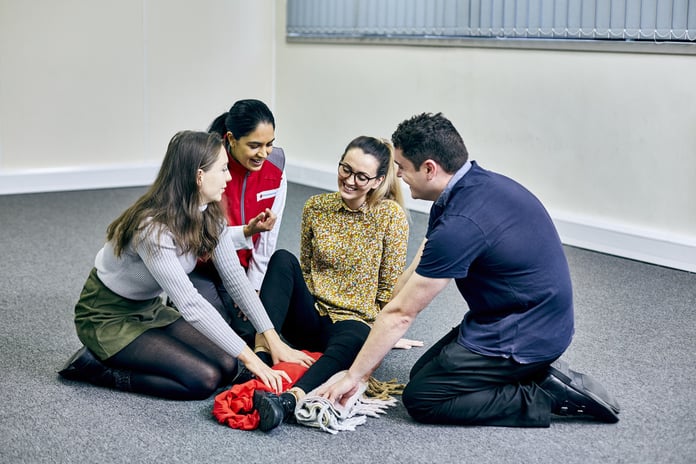Hazards and risks play a major part when you determine what equipment, facilities and personnel are needed for first aid in your workplace. To conduct an accurate first aid needs assessment, it’s important to understand the distinction between a hazard and risk, as well as how they influence each other.
This blog looks at the difference between risks and hazards in the workplace and how they influence the first aid provision you need.
What’s the difference between risk and hazard?
A workplace hazard is something that could potentially cause harm, injure, or have an adverse effect on a person’s health. Examples could include physical hazards such as slippery floors, chemical hazards like acids and solvents, or psychosocial hazards such as stress and long working hours.
A risk, on the other hand, is the likelihood of someone being harmed or experiencing adverse health effects if exposed to a hazard. Risk takes into account factors such as the frequency and duration of exposure to the hazard, the severity of the potential harm and the vulnerability of the individuals involved.
Let’s take the example of hydrochloric acid. If someone works with hydrochloric acid, then the acid is a hazard. The severity of harm that could occur from the hazard is high. If it's inhaled it can cause breathing problems. If it gets in the eyes it can cause blindness and if it’s splashed on the skin it can cause burns.
While hydrochloric acid is a high-level hazard, it is possible to manage and reduce the risk it poses. If employees use PPE (Personal Protective Equipment) such as respirators, rubber gloves, face shields and other protective clothing, there is a much lower risk of breathing in or splashing the substance into eyes or onto skin.
Providing adequate training in handling the acid and ensuring inexperienced workers are supervised reduces the risk of accidents. Additionally, providing adequate first aid equipment, such as eyewash stations and first-aid-trained personnel helps reduce the degree of injury that is likely to occur.
Introducing appropriate safety measures helps you manage the levels of risk in your workplace. This then reduces the level of impact on your first aid provision.
Ensure your team are safe and compliant at work
Click the button below to access our course finder, an interactive tool designed to help you discover courses tailored to your specific requirements.
Hazards, risks and first aid needs assessments
Both hazards and risks influence the first aid provision you need in the workplace.
While both are often identified in a routine risk assessment, it is also important to undertake a thorough first aid needs assessment as required by the Health and Safety (First-Aid) Regulations 1981. This allows you to focus on potential outcomes in terms of injury or illness, or their prevention. Only by doing this can you properly consider what equipment, facilities, and trained first aid personnel are needed for your specific workplace.
To help you compile a robust first aid needs assessment, we have outlined some common types of hazards to look out for and suggested ways you can manage the risk they pose.

Common workplace hazards
What is a hazard in the workplace?
This is not always something that’s easy to identify.
One useful tip is to think first about the main categories that hazards belong to. These can help you pinpoint the specific hazards in your working environment.
Common categories of hazards include:
- Physical hazards. These include anything that can cause physical harm, such as slippery floors, falling objects, unguarded machinery, noise and vibration.
- Chemical hazards. Exposure to toxic substances like solvents, acids, gases or fumes that can lead to chemical burns, respiratory issues and other health problems. Some chemicals are also carcinogenic, meaning exposure can increase the risk of cancer.
- Biological hazards. These hazards include exposure to bacteria, viruses, fungi and other microorganisms, potentially causing infections and diseases. These hazards are most likely in environments such as laboratories and hospitals, but can still occur elsewhere. For example, if your premises have water systems, you might need to take steps to ensure legionella or other pathogens don’t take hold.
- Ergonomic hazards. Examples of these include poorly designed workstations and improper lifting techniques that can lead to musculoskeletal disorders or repetitive strain injuries.
- Psychosocial hazards. It’s important to take account of factors like workplace violence, stress, bullying, and long working hours that can adversely affect mental and emotional well-being.
How you manage risk depends on the hazards you identify. For example, if employees use machinery, you’d need to ensure that they are properly trained in its use.
Make sure your team are prepared for anything
Use our course finder tool to discover which of our First Aid at Work training courses are suitable for your business, ensuring your compliance needs are met.
How hazards and risks help determine your first aid provision
When there are hazards in the workplace, managing their risk helps reduce the likelihood of accidents or illness. That said, it’s still essential to have adequate first aid provision in place in case something does go wrong.
Once you have completed your first aid needs assessment, you’ll be able to look more closely at your first aid provision in order to determine the following:
- Sufficient numbers of first aiders. It’s essential to have adequate numbers of trained first aiders in every workplace. There are rules about the minimum numbers of first aiders you need, as well as the type of training they should have completed. These depend on how many employees you have and whether you have a low-hazard or higher-hazard workplace. You can learn more in our blog post on how many first aiders are required for a workplace. It’s also important to remember you need sufficient first aiders on the premises at all times, including at lunch times, during breaks, and throughout all shifts, even when colleagues are on holiday.
- Adequate first aid training. You need to make sure that your first aiders have an appropriate level of training. If you have a higher-hazard workplace, it’s wise to make sure your first aiders have First Aid at Work training. This level 3 qualification takes three days to complete and gives first aiders a broad range of skills suitable for higher-hazard environments. You may identify specific hazards that need specialist training.
- Sufficient and appropriate first aid equipment. You minimise risk when you have sufficient and appropriate first aid equipment. Your first aid needs assessment should identify any hazards that might require specific equipment. For example, if people work with acids or alkalis, it’s a good idea to provide chemical splash kits. These contain pH neutralising solutions that can help reduce the risk of corrosion or lasting injury. You also need to make sure sufficient first aid kits and other equipment can be easily and quickly accessed in all areas of your premises.

Identifying any needs for additional first aid provision
When it comes to implementing the right first aid provision, the key things you need to do are have sufficient first aiders with the right training, along with making sure you have the right first aid equipment.
Meeting additional needs is normally relatively straightforward, but you may need first aid training courses that address hazards in your specific workplace.
For example, in forestry, chainsaw injuries could result in catastrophic bleeding, while suspension trauma can arise from working in harnesses at height. These are not routinely covered in a standard First Aid at Work course, so you would need to request for these things to be covered.
Similarly, if your workplace is at a distance from the emergency services, it’s wise to have enough highly trained first aiders. If there are specific hazards such as machinery or electricity, it is also a good idea to inform the emergency services so they know to bring the right equipment and personnel in any emergency.
With regard to first aid equipment, a low-risk environment such as an office may only need one or more suitably stocked first aid kits. In some industries, you may need specialist equipment that goes far beyond what even the HSE recommends you consider.
To give an example, we worked with a customer in a high-security industry. In the event of an accident, emergency services would have to pass numerous security checks to get through the site. This would result in further delays whilst waiting for the area to be safe to enter.
As the workplace also contained high-level hazards, this customer identified the need for additional equipment such as medical gases, splints, and stretchers so that they could remove someone from a hazardous area quickly. This went far beyond the standard requirement.
Adequate first aid provision can help to improve the outcomes of injuries and illnesses that occur, so it's important to fully understand your duties.
Ultimately, the responsibility falls on you as an employer to undertake a first aid needs assessment to determine the appropriate level of provision for the hazards and risks in your workplace. If you need first aid training for your staff, get in touch today to discuss your needs.
Topics: First Aid





